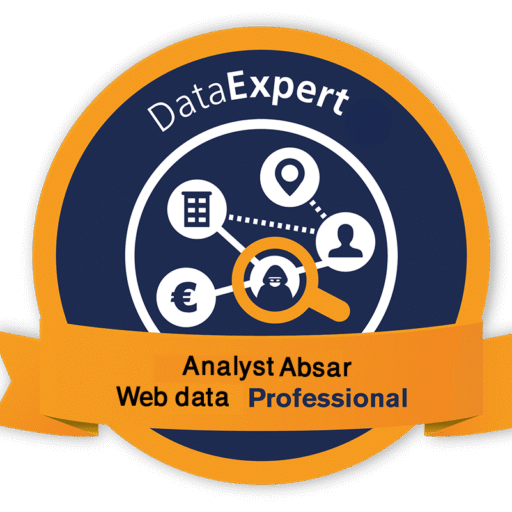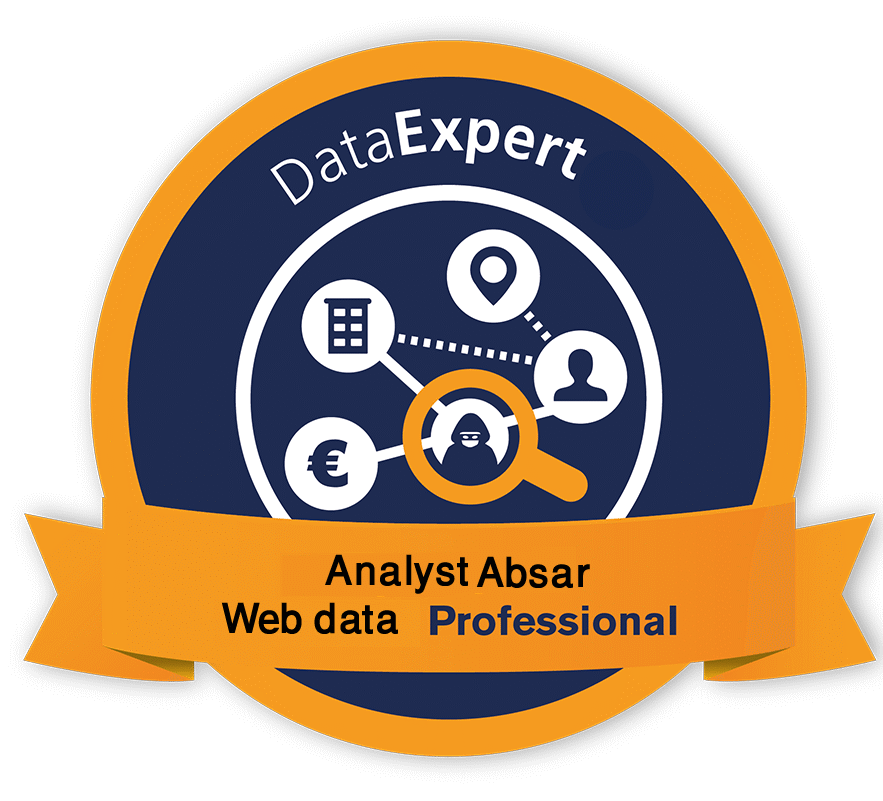First-Party Data :
The Key to B2B Marketing Success in 2025
Leverage accurate, permission-based insights to build trust, drive conversions, and future-proof your B2B marketing strategy.
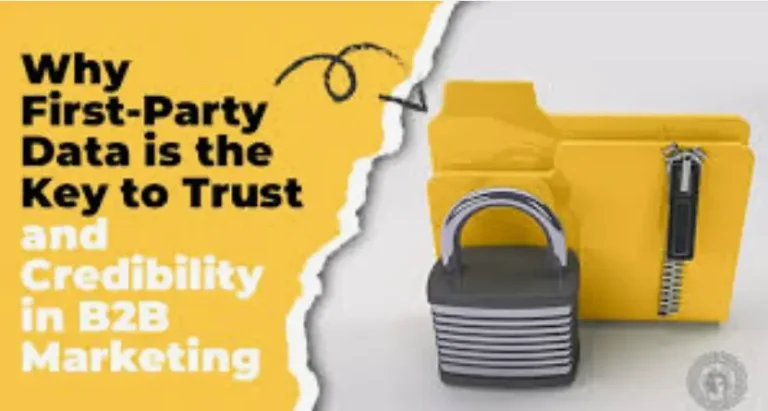
Analytics ⑊ First-Party Data

- Post by : Absarjoy
- 5:56 am
- August 16, 2025
In today’s privacy-driven digital landscape, first-party data has become the cornerstone of effective B2B marketing. Unlike third-party data, it is collected directly from prospects and customers, ensuring accuracy, transparency, and reliability. By leveraging first-party data, businesses can build trust and credibility, strengthen relationships, and deliver more personalized experiences that drive higher conversions. As regulations tighten and buyer expectations evolve, companies that embrace first-party data will be better positioned to create sustainable strategies, unlock long-term growth, and maintain a competitive edge.
What Is First-Party Data?
First-party data is information collected directly from users with their consent, through owned channels like:Website interactions,Email campaigns etc.
Unlike third-party data, which is aggregated across domains, first-party data is accurate, relevant, and privacy-compliant—making it a critical asset in 2025’s marketing ecosystem.
Sources of first-party data include:
- Website or app behavior
- Email and newsletter subscribers
- Lead generation campaigns
- Surveys
- Social media
- Subscriptions
- Customer feedback
- Customer service/sales conversations
- Online chat
Through these channels, you can gain insight and leverage customer and business data. Types of data include demographics, website activity, email engagement, sales interactions, feedback and purchase history along with returns information and stock levels.
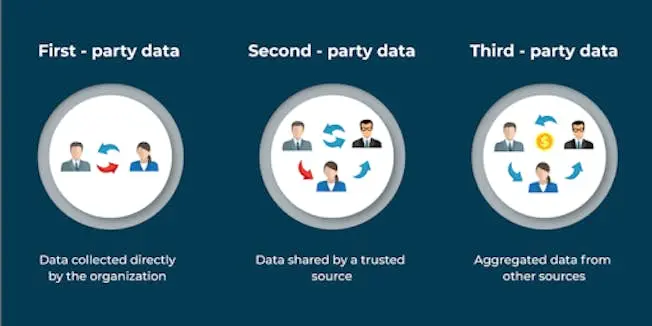
Why First-Party Data Is a B2B Superpower
Unlike B2C, B2B buying cycles are long, complex, and involve multiple stakeholders. First-party data helps marketers:
Identify decision-makers early
Segment by firmographics like company size or industry
Track behavior across multiple content pieces
Personalize nurture journeys based on real intent
According to a McKinsey B2B Pulse Survey (2024), companies that heavily invest in first-party data strategies see 20–30% higher conversion rates than those relying on third-party cookies.
🚨Why it is Important to Shift From Third-Party Data to First-Party Data?
In all these years, businesses have relied on third-party data to make their business decisions. However, now due to the change in GDPR and CCPA regulations, businesses have to be more compliant while making their strategies.
Challenges of Third-Party Data in B2B Marketing
- Lack of Trust:
B2B decision makers prefer engagement and interactions based on consent and transparency rather than intrusive tracking.
- Regulatory Risks:
Change in the data protection laws makes it difficult to collect the data from the users, hence it affects the accuracy of the data.
- Data Accuracy Issues:
Data collected from a Third party is often outdated, which leads to the poor targeting and wasted marketing efforts.
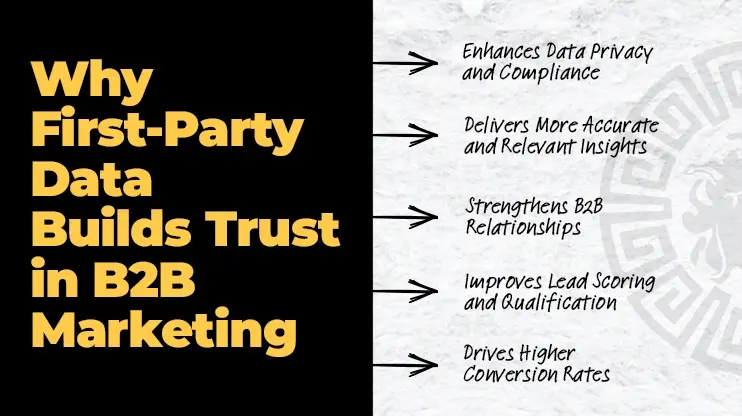
What Are the Benefits of First-Party Data?
Since first-party data is collected and owned exclusively by your business, it provides deep, reliable insights into your audience that competitors cannot access. This unique advantage brings several key benefits:
- Personalization & Integration – Deliver tailored experiences across channels.
- Target the Right Customers – Reach the prospects most likely to convert.
- Accuracy & Control – Rely on precise, high-quality data you fully manage.
- Stronger Customer Relationships – Build trust through relevant and timely engagement.
- Privacy Compliance – Stay aligned with evolving data protection regulations.
- Transparency – Clearly show customers how and why their data is used.
- Lower Costs – Reduce reliance on expensive third-party data sources.
Beyond these benefits, first-party data gives you a competitive edge by keeping your strategies and decisions unique. While third-party data was once accessible to everyone, your exclusive audience insights now set you apart—helping you innovate and stay ahead.
Key Challenges in Collecting First-Party Data
While first-party data is incredibly valuable, many businesses still struggle to unlock its full potential. According to research by Google in the APAC region, both organizational and technological challenges often stand in the way.
On the technological side, one of the biggest barriers is the inability to integrate and link different systems, often due to teams working in silos or relying on outdated infrastructure. A lack of understanding of data—how to collect, interpret, and apply it—also limits its effective use.
From an organizational perspective, poor team structures, limited cross-department collaboration, and a shortage of skilled talent pose significant challenges. With digital skills in high demand, many companies find it difficult to recruit or develop the expertise needed to manage and analyze data effectively.
To overcome these barriers, businesses must invest in integrated technologies, break down silos, and build teams with the right digital and analytical skills. By doing so, companies can ensure their data is not only collected but also transformed into actionable insights that enhance customer experiences and deliver measurable ROI.
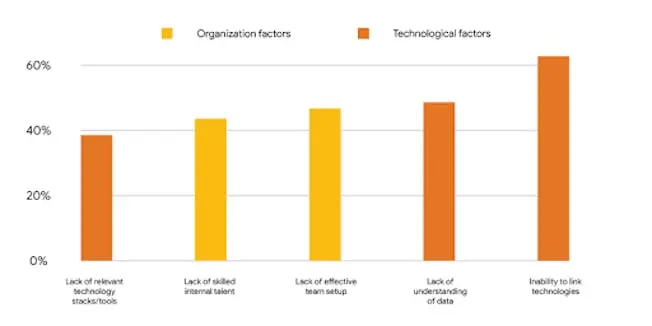
🛠️ How to Collect & Leverage First-Party Data
1. Optimize Your Website for Data Capture
- Use lead magnets like:
- Whitepapers
- Case studies
- Free tools
- Webinar registrations
- Whitepapers
- Include smart forms to collect:
- Name
- Email
- Job title
- Company size
- Buying intent
- Name
2. Integrate CRM and Marketing Automation
- Track interactions across channels (email, chat, site visits)
- Build progressive lead profiles
- Score leads based on behavior and engagement
3. Segment and Personalize Campaigns
- Send targeted content based on:
- Industry
- Pain points
- Stage in the funnel
- Industry
- Customize messaging across:
- Email
- Retargeting ads
- Landing pages
- Email
4. Respect Privacy and Build Trust
- Always collect data with clear consent
- Make opt-ins and data usage transparent
Allow users to manage preferences or opt out
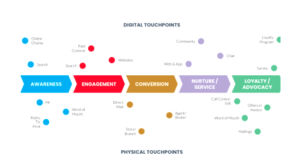
🚀 First-Party Data Activation: From Capture to Conversion
Step 1: Capture
Collect opt-in data through gated content, webinar sign-ups, and interactive tools.
Pro Tip: Use value-driven CTAs, e.g. “Download our free 2025 Compliance Checklist for Fintech Leaders.”
Step 2: Enrich
Enhance your database with firmographic and behavioral insights from tools like:
- Clearbit
- Leadfeeder
- LinkedIn Sales Navigator
Step 3: Segment
Group contacts by role, funnel stage, industry, or behavior to deliver relevant messaging.
Step 4: Activate
Use CRM and marketing automation platforms to:
- Trigger drip campaigns
- Deliver personalized content
- Retarget across email and social channels
Step 5: Analyze
Measure performance by tracking:
- Conversion paths
- Content engagement
- Pipeline attribution
Recommended Tools: HubSpot, Marketo, GA4
Real-World Example: Cybersecurity SaaS Success
A cybersecurity SaaS company distributed a gated eBook on ransomware prevention via WhitepapersOnline.
Execution:
- Captured leads through gated landing pages
- Synced to HubSpot CRM
- Segmented by industry (finance, healthcare, etc.)
- Sent role-specific nurture emails
- Retargeted engaged leads on LinkedIn
Results:
- 63% open rate on follow-up emails
- 41 qualified leads
- $120,000 pipeline generated in 3 weeks
💡 Final Thoughts
First-party data isn’t just a trend—it’s the future of B2B marketing. As third-party data disappears and buyers expect more tailored experiences, first-party data becomes your most valuable marketing asset.
If you haven’t already, now’s the time to invest in building your first-party data strategy. Because the companies that control their data will control their market.
Latest Projects
Maximize Your ROI: Performance Max Campaign Strategy Insights
Google Ads Remarketing
Facebook Pixel Conversion API
Web Analytics demo
Stay updated on our best deals in CRO, Analytics, and Advertising
Best Marketing Tools

Andry Brook
Chef Director, Rafel Fashion Ltd, UAE
And once connected to Google Analytics, Meta’s system is then able to use aggregated data from Google to establish more context for your web traffic, which, in combination with the Meta Pixel and the Conversions API, could help to provide more understanding of key performance drivers for your campaigns.And once connected to Google Analytics, Meta’s system is then able to use aggregated data from Google to establish more context for your web traffic, which, in combination with the Meta Pixel and the Conversions API, could help to provide more understanding of key performance drivers for your campaigns.

Anamica Sen
Director Sales
We honestly reference Hostinger as the benchmark for our engineers when providing support. We honestly reference Hostinger as the benchmark for our engineers when providing support.We honestly reference Hostinger as the benchmark for our engineers when providing support.

Synthi Hook
Managing Director, Soft Fashion Ltd, Canada
one place, which was really refreshing.I could manage the hosting, domain name, and SSL certificate in one place, which was really refreshing.I could manage the hosting, domain name, and SSL certificate in one place, which was really refreshing.I could manage the hosting, domain name, and SSL certificate in one place, which was really refreshing.

Testi
Techno, UAE
manage the hosting, domain name, and SSL certificate in one place, which was really refreshing.I could manage the hosting, domain name, and SSL certificate in one place, which was really refreshing.I could manage the hosting, domain name, and SSL certificate in one place, which was really refreshing.

Robert Lee
Techno Manager, United States
I could manage the hosting, domain name, and SSL certificate in one place, which was really refreshing.
Thanks for vising my blog post
Reach out for 1st Party Tracking setup and expert assistance.
